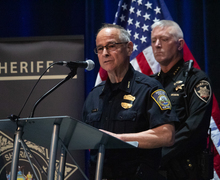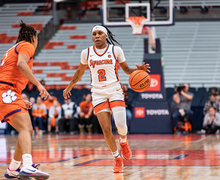Chancellor Kent Syverud discloses how many SU staffers took the buyout at University Senate meeting
Daily Orange File Photo
Chancellor Kent Syverud said 254 employees took part in Syracuse University’s Voluntary Separation Incentive Program, which was offered to employees whose combined age and years of service were higher than 65.
UPDATED: Feb. 18, 2016 at 4:56 p.m.
A new report from a group in the Fast Forward Syracuse initiative details eight areas upon which Syracuse University may mold its mission and vision for students in the future.
The 14-page report, titled “4+4,” was presented by the Academic Strategic Plan’s Student Experience Working Group to the University Senate Wednesday afternoon. The report identifies eight core competencies, using jargon-filled language such as creative, scientific and critical reasoning and applied and collaborative learning competency, among others.
The competencies lay out the types of academic and personal experiences that students can expect to carry with them upon graduating from SU, said Terra Peckskamp, a co-chair of the group who presented the report to the senate.
“Many institutions, and Syracuse has not done this previously, have a statement or a vision that says, ‘A Syracuse University graduate will or does this,’” said Peckskamp, who is also the director of the Office of Residence Life, after the meeting. “So that’s where the competencies come from.”
Before the workgroup issued its report, Chancellor Kent Syverud addressed the senate, sharing key details on the employee buyout program. At last month’s senate meeting, philosophy professor Sam Gorovitz asked the chancellor to release specific numbers on how many university employees took the buyout.
Syverud said 254 employees took part in SU’s Voluntary Separation Incentive Program, which was offered to employees whose combined age and years of service were higher than 65. He added that the 254 employees who took the buyout represent 6.9 percent of the total benefits-eligible staff, which totals 3,656. The total benefits-eligible staff represents those who could have taken part in the buyout if they met the requirements of their age plus years of service equaling 65 or more, said Kevin Quinn, senior vice president for public affairs at SU, in an email.
Syverud also briefly touched on the timeline for devising the university’s 2017 budget. In March, the Board of Trustees executive committee will review the budget proposal for 2017, including tuition and room and board pricing. The entire Board of Trustees will then approve the budget in May.
Peckskamp said she hopes to also present the 4+4 report to the Board of Trustees in May. To do that, she said the report must first be evaluated by the university community.
The process will move quickly so that SU is ready to be evaluated starting in the fall for accreditation by the Middle States Commission on Higher Education. The commission makes sure that higher education institutions meet certain standards, and a mission or vision for students is one of the requirements, Peckskamp said. Several of SU’s peer institutions, such as Cornell University and Georgetown University, are Middle States accredited, according to the commission’s website.
The senate also heard from the Committee on Instruction, wherein Committee Chair Robert Van Gulick discussed a meeting with SU Athletics. The meeting came after the Senate Agenda Committee requested it focus on the NCAA infractions in the athletics department.
The Committee on Instruction chose to look into academic support services and academic integrity in the athletics department, eventually meeting with Tommy Powell, the assistant provost for student-athlete development.
Powell described the current state of academic support services, noting that the number of tutors for student-athletes has grown from 35 to 140 in recent years. Student-athletes are also in good shape relative to the NCAA’s definition of Academic Progress Rate: all teams currently have a 94 percent success rate among their athletes, Powell said.
The progress rate describes whether or not students are on track to complete their degree in four or five years. It does not, however, reflect graduation rates in the athletics department, Van Gulick said.
“In fact, it’s not set up in such a way that it’s pegged on graduating in four years,” Van Gulick said, adding that he would like to see specific graduation data from the Senate Committee on Athletic Policy.
The report listed several other requirements for student athletes who are seniors, as outlined by the NCAA. These requirements include that student athletes must have a minimum cumulative GPA of 2.0, be registered for 12 credit hours per semester and complete 80 percent of their degree by the end of their fourth year of college.
The committee also recommended that any newly hired faculty be educated on academic support services for student athletes at SU.
CORRECTION: In a previous version of this article, the SU employees eligible for the buyout was misstated. The buyout was offered only to staff members. The Daily Orange regrets this error.
Published on February 17, 2016 at 11:02 pm
Contact Annie: [email protected]




